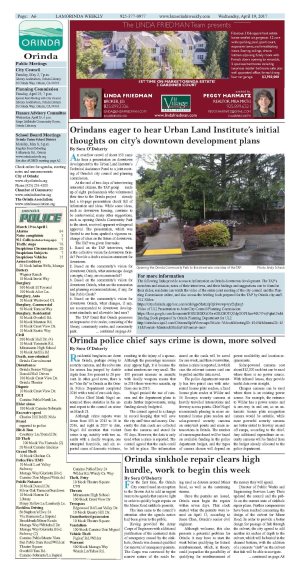| | Published April 19th, 2017
| Orinda police chief says crime is down, more solved
| | | By Sora O'Doherty | | |
Residential burglaries are down in Orinda, perhaps owing to security cameras, and the solve rate for crimes has jumped by double digits from five percent to 28 percent. In other good news, there is no "blue flu" in Orinda as the Orinda Police Department completed 2016 with a total of zero sick days.
 Police Chief Mark Nagel announced these statistics in his annual report to the council on crime on March 21.
Police Chief Mark Nagel announced these statistics in his annual report to the council on crime on March 21.
 Although crime reports were down from 103 in 2012 to 36 in 2016, and eight in 2017 to date, Nagel did mention that violent crime is up, notably with two assaults with a deadly weapon, one attempted homicide, and six reported cases of domestic violence, resulting in the injury of a spouse. Although the percentage increases may appear high, it is because the actual numbers are very small. The 100 percent increase in assaults with deadly weapons means that in 2016 there were two assaults, up from one in 2015.
Although crime reports were down from 103 in 2012 to 36 in 2016, and eight in 2017 to date, Nagel did mention that violent crime is up, notably with two assaults with a deadly weapon, one attempted homicide, and six reported cases of domestic violence, resulting in the injury of a spouse. Although the percentage increases may appear high, it is because the actual numbers are very small. The 100 percent increase in assaults with deadly weapons means that in 2016 there were two assaults, up from one in 2015.
 Nagel praised the use of cameras and the department plans to make further improvements, using funding already budgeted.
Nagel praised the use of cameras and the department plans to make further improvements, using funding already budgeted.
 The council agreed to a change in record keeping that will save the city staff time and money. Currently the data cards are collected from the cameras and stored for 90 days. However, the data is only used when a crime is reported. The council agreed that the cards could be left in place. The information stored on the cards will be saved for one week, and then overwritten, unless a crime is reported, in which case the relevant camera card can be pulled and the data saved.
The council agreed to a change in record keeping that will save the city staff time and money. Currently the data cards are collected from the cameras and stored for 90 days. However, the data is only used when a crime is reported. The council agreed that the cards could be left in place. The information stored on the cards will be saved for one week, and then overwritten, unless a crime is reported, in which case the relevant camera card can be pulled and the data saved.
 The police department currently has two patrol cars with automated license plate readers, a fixed license plate reader at Wilder and 16 Reconyx security cameras at heavily travelled intersections and freeway access points. Chief Nagel recommends phasing in more automated license plate readers and solar-powered security cameras on entry/exit points and main intersections in Orinda. The number of cameras purchased will be based on available funding in the police department budget, and the types of camera chosen will depend on power availability and location requirements.
The police department currently has two patrol cars with automated license plate readers, a fixed license plate reader at Wilder and 16 Reconyx security cameras at heavily travelled intersections and freeway access points. Chief Nagel recommends phasing in more automated license plate readers and solar-powered security cameras on entry/exit points and main intersections in Orinda. The number of cameras purchased will be based on available funding in the police department budget, and the types of camera chosen will depend on power availability and location requirements.
 Solar-powered cameras cost about $12,000 each but can be used where there is no power source. With infrared lenses, they provide useful data even at night.
Solar-powered cameras cost about $12,000 each but can be used where there is no power source. With infrared lenses, they provide useful data even at night.
 Cheaper cameras can be used where there is an existing power source. For example, the entrance to Wilder has a power source and is one-way in and out, so an automatic license plate recognition camera would be suitable, while more powerful security cameras are better suited to freeway on and off ramps, according to the chief. Any additional expenditure on security cameras will be funded from the budget already allocated to the police department.
Cheaper cameras can be used where there is an existing power source. For example, the entrance to Wilder has a power source and is one-way in and out, so an automatic license plate recognition camera would be suitable, while more powerful security cameras are better suited to freeway on and off ramps, according to the chief. Any additional expenditure on security cameras will be funded from the budget already allocated to the police department.


|
| | | | | | | | | | | | |


